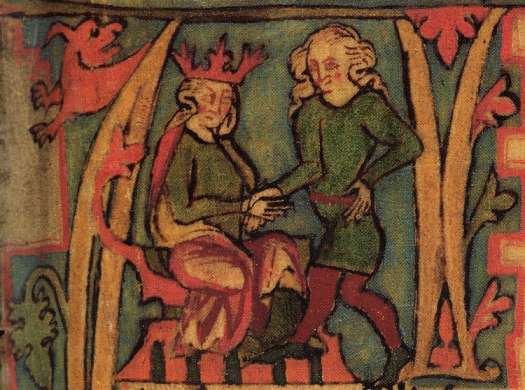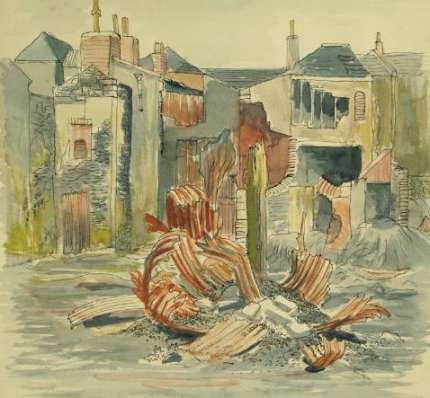What exactly caused the massive westward expansion of Vikings in the late 8th century? There is, as of now, no definitive explanation. A number of scholars – including Collard, Price, and Raffield in the modern day, as well as Dudo of Saint-Quentin in the 10th century – have suggested that the lack of women in Scandinavia was the main reason why young men went a-viking.
Others, including Dumezil and Dillman in the 20th century, and Einhard in the 9th century, have suggested that the raids began in retaliation for Charlemagne’s wars against the Saxons in the 8th century. That might explain the attacks in France, and particularly the attacks launched on Francia from Denmark, but doesn’t really explain the raids into Britain and the settlement of islands in the North Atlantic like Iceland and Greenland. However, for some, like Erik the Red who was exiled from both Norway and Iceland, the reasons were more personal.
What does help to explain why the Vikings were all over the North Atlantic (and into Eastern Europe, Southern Europe, Northern Africa, and the Middle East) is silver. Silver was the metal of choice for trade, and Vikings were traders as well as warriors. Huge hoards of silver coins with origins ranging from Britain to Russia to Iran to northern India have been found in Scandinavian graves from the Viking age – the Sundveda Hoard, for example, has 482 coins in it, and all but one have Eastern, Middle Eastern, or Indian markings on them. Even modern cities with Viking Age origins like Dublin and Bergen still have strong ties to silversmithing and trading.
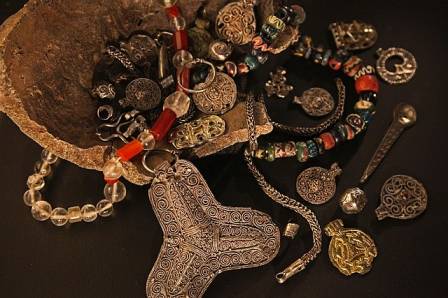
Timeline of the Westward Expansion
So, when did the Viking age begin? Well, that does depend on a lot of factors, not the least of which is where you happen to be. In the English-speaking world, the commonly held date is 8 June, 793 CE. This is the day that Viking ships landed at the abbey of Lindisfarne and it was sacked by Viking raiders, and marks the start of a very large upswing in raiding and violence in Britain and Europe from Scandinavians.
Of course, like everything related to the early Viking Age, it’s not quite that simple.
There was undoubtedly contact between the Scandinavians and Britons before the raid on Lindisfarne, and not all of it was peaceful. Of course, peaceful trade had happened often enough for a royal reeve named Beaduhard to be killed by Vikings when he thought he was actually talking to a band of friendly traders in 789.
Elsewhere in Europe, Scandinavian attacks begin both earlier and later than 793 CE. In Estonia, we have evidence of pirate activity across the Baltic Sea, with archaeological evidence (Curry; Magi, pp. 233-234) supporting the story from chapter 36 of Ynglinga saga where the Swedish king Ingvarr was killed in a raid during the 8th century. Meanwhile, in the Frankish kingdoms, we don’t start hearing about Northmen attacking until the 9th century, with Einhard’s accounts (Einhard, p. 14)
Of course, the end-point is also debated, but it’s generally accepted that sometime between the conversion of Iceland in 1000 and the Norman Conquest of 1066 (Jesch, pp. 9-10).
England
(Note: All dates are referenced from the Anglo-Saxon Chronicle unless otherwise noted)
England had been in contact with Scandinavians long before the Viking age began. It was, apparently, most often through trade that the Anglo-Saxons were familiar with their Scandinavian cousins, though, in the last decades of the 8th century, that would all change.
The first recorded Viking attack in Britain was in Wessex, in the year 789 when the royal reeve Beaduheard was killed by what he had thought were traders coming ashore on the island of Portland. The extent of their raid was not recorded. After that, numerous smaller raids and attacks occurred, but it wasn’t until 793, when the holy island of Lindisfarne was sacked, that the Viking age truly began in Britain.
After Lindisfarne, other religious sites were sacked across the northern Anglo-Saxon coasts, including Monkwearmouth-Jarrow Abbey, which was located near Lindisfarne as well (Blair, p. 55) The first recorded Viking raid in southern Britain was in 835, against the Isle of Shippey in Wessex.
These raids continued for another 30 years, until 865, when the Danes invaded, seeking new territory to colonize and settle in. By 876, the Danes had conquered a vast stretch of northeast England, claiming it as the Danelaw, and held it until the middle of the 10th century, when they were driven out of York (Abrams, pp. 138-139)By the 11th century, at the end of the Viking era, the last great battle fought by the Vikings in England was at Stamford Bridge by king Haraldr harðráði of Norway. The Norwegians were defeated, but the Anglo-Saxons soon fell to the descendants of the Vikings who had raided France nonetheless.
Scotland
Like their Saxon neighbors to the south, Scotland was not immune to Viking invasions in the 8th century. In 795, just three years after Lindisfarne was sacked, Iona Abbey, on the west coast of Scotland, was attacked by Vikings. The raids against Iona did not let up, and the abbey was eventually abandoned in 849.
There are precious few documents detailing the Viking incursions in mainland Scotland, though the repeated attacks on Iona suggest that there was at least some infrastructure in place to support raids along the western coastline. Orkneyinga saga, a Norse saga about the colonization of the Orkneys and the establishment of the Earldom there, would suggest that the Vikings were raiding from the northern and western isles of Scotland into the mainland and Ireland. Another, more controversial position is that the Vikings established a kingdom across broad expanses of the Scottish coastline and raided from there (Ó Corráin) Unfortunately, there is very little in terms of archaeological or literary evidence to support that theory.
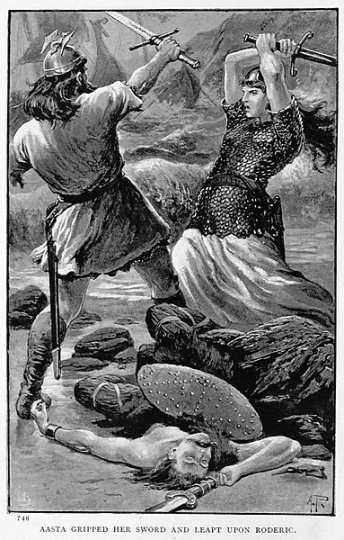
There is, however, evidence that the Vikings settled and integrated with existing Scottish communities along the west coast. In the 9th century, references to the Gall-Ghàidheil, or foreign Gaels, begin appearing, and the term was used eventually to refer to all Scandinavian-Celtic peoples. Place names – like that of Galloway, in southwest Scotland – also suggest that the Vikings integrated themselves quite tightly with the Scots. The first Viking boat burial to be discovered on mainland Britain is also in Scotland: the Port an Eilenn Mhòir boat burial. The burial was discovered in 1924, at Ardnamurchan, the most westerly point on mainland Britain.
Ireland
(Note: All dates are referenced from the Annals of Ulster unless otherwise noted)
Much like Britain, Ireland was a target of the Vikings during the late 8th century, and, much like Britain, the first major recorded attack on Ireland was a raid on an island called Rechru, whose actual location is now lost (Ó Corráin, pp. 9-10) Later raids occurred along the coasts of the Irish kingdoms of Brega and Connacht (Bryne, pp. 609-610,) and continued along the west coast of Ireland into the middle of the 9th century. These raids were simply for plunder, rather than permanent settlement (Ó Corráin II, pp. 3-4,) although that would soon change.
In 841, Vikings attacked Dublin, as they had before, but this time it was no simple raid. The Vikings instead settled in Dublin, building military and naval camps and fortifying the city. They used Dublin as a base from which to raid all across Ireland, striking particularly into Leinster and the Midlands, and by 845 they had established bases across the kingdom of Leinster.
Things weren’t all easy for the Vikings, though. In 848 the Irish attacked Dublin and defeated them in a number of battles. The situation got so dire that Ólafr hinn hvíti and Ívarr hinn beinlaussi arrived in 849 to settle the situation and restore Viking authority. They managed to do this extremely well and resumed raiding across Ireland.
Ólafr died in 871, and Ívarr soon after, in 873, but the children Ívarr formed the Uí Ímair dynasty, which would play a major role in Irish and British politics for the next hundred years.
The Isles
In 872, Haraldr hinn hárfagri became the first king of a unified Norway, and his defeated opponents fled to the Scottish islands. Not one to leave a threat waiting for him, Harald followed them and defeated them by 875, when he declared the islands to be under Norwegian control. That lasted about a decade, until the inhabitants of the Hebrides rebelled, and eventually declared themselves independent. Haraldr sent Ketill fláttnef to return the islands to Norwegian control, but he wound up declaring himself the King of the Isles instead – not quite what Haraldr had hoped for.
The northern isles – the Orkneys and Shetland islands – were ruled by the Earls of Orkney, and that earldom was a gift from Haraldr to Rǫgnvaldr Eysteinsson, in compensation for the death of his son while fighting in Scotland. Rǫgnvaldr did not particularly want the earldom and gave the title to his brother Sigurdr. Eventually, Einarr Rǫgnvaldsson would solidify the rule of the Orkneys and Shetlands around 890, and rule until his death in 910.
The Viking influence in the isles of Scotland wasn’t restricted to the northern islands, however. The Hebrides – which had revolted against Haraldr and declared themselves independent around 885 – continued to remain at least occupied, if not ruled, by Vikings well past the end of the Viking age (Sharples and Smith) The Kingdom of the Isles also controlled the Isle of Mann, and the influence of the Vikings culture is still evident in the modern Manx place- and personal-names (Broderick).
France
The Viking invasions and occupations of France happened in a relatively short time and took advantage of the massive disruption in the Frankish kingdoms after the death of Charlemagne and the subsequent partitioning of his empire. By 843, Charles the Bald was established as King of West Francia, and was dealing with raids launched by a Norse chieftain by the name of Reginherus – though modern readers may know him better as Ragnar loðbrókr. According to the Annals of Xanten, Ragnar attacked Paris in 845 and occupied the city, ransacking it and leaving only after a ransom of over 2.5 tonnes of silver and gold were paid (Ogg, p. 166)
On 25 November of 885, Paris was attacked again, this time by Hrólfr, Sigfred, and Sitric. The three warlords brought a force of over 10,000 men with them and laid siege to the city after the Count of Paris, Odo, refused to pay them ransom. The siege lasted over the winter and, by February of 886, King Charles the Fat paid the besieging Vikings 700 pounds of gold and silver to leave and attack the Burgundians further downriver. Most of the Viking army left, but Sigfred’s group stayed until October of that year.
These massive attacks were so devastating to the Frankish kingdom that, in the summer of 911, king Charles the Simple signed the treaty of Saint-Clair-sur-Epte which granted Hrólfr the territory that would become the Duchy of Normandy in exchange for peace between the Vikings and Franks.
Iceland
(Note: All dates are referenced from Landnámabók, unless otherwise noted)
Sometimes you take a wrong turn and find a great new coffee shop. A Norwegian named Naddoðr got lost in a storm during a journey to the Faroe Islands and discovered Iceland in 860 CE. He landed on the east coast, climbed a mountain to look for any signs of habitation, found none, and made his way back to the Faroes.
Naddoðr was likely not the first person to find the island, though. Landnámabók, the history of the settlement of Iceland, says that a group of Christians called the Papar lived there before the Norse settled. Despite the fact that the Papar may have lived in Iceland from about 800, there is no evidence of them outside of one small area on the south coast, though, which means that the first permanent settlement was made by Ingólfr Arnason, a Norwegian.
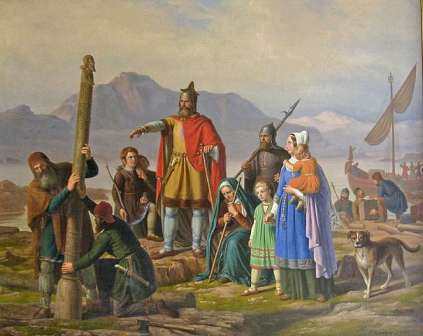
Ingólfr made his way west from Norway, following the stories told of another Norseman, Hrafna-Flóki Vilgerðarson, who had overwintered in the Westfjords of Iceland previously. Hrafna-Flóki got his nickname – Raven-Flóki – by bringing three ravens with him when he left the Faroes to find Iceland. One went back to the Faroes, the second returned to his ship, and the third and final one flew westward, towards Iceland.
By 874, Ingólfr had made a settlement at what is now Reykjavík, and others began to join him. By 930 CE, Iceland was considered to be fully settled: The land had all been claimed and divided, and Alþingi, the national assembly of Iceland, had been established in Þingvellir.
Greenland
(Note: All dates are referenced from Grænlendinga saga, unless otherwise noted)
Greenland was settled near the end of the Viking age. The Norse colonies there actually lasted well into the 14th century. Just like with Iceland, the locations of the Greenland colonies were unpopulated when the Norse arrived, which meant that there was no raiding or other violence against the original inhabitants of the area.
While it wasn’t settled until the end of the 10th century, Greenland’s existence had been known to the Vikings since at least the 930s. Gunnbjörn Ulfsson, one of the settlers of Iceland, was once blown off course while sailing to Iceland from Norway. He then spotted some small islands between Iceland and what we now know as Greenland. It wasn’t until 978 that those islands were revisited, though. Then, according to a lost saga, Snæbjörn galti used them as a staging ground to attempt settling Greenland. That attempt, though, ended in disaster, and Snæbjörn was killed by his fellow colonists, who promptly abandoned the attempt.
Around 982, Eirikr hinn rauði was exiled from Iceland “due to some killings” for three years. He opted to try and start a settlement in Greenland, rather than returning to more populated areas. After spending the three years in exile, he returned to Iceland and drummed up support to start a new colony. He left with 25 ships, but only 14 survived the journey. Despite that, they founded the Eastern and Western Settlements,. They flourished as trading hubs, sending ivory, fur, and hides from the narwhal, walrus, and polar bears that they hunted to Iceland, and from there further east.
Vinland
(Note: All dates are referenced from Grænlendinga saga and Eiríks saga rauða, unless otherwise noted)
The first Viking to spot Vinland was Bjarni Herjólfsson, who was blown off course while traveling to Greenland from Norway. He spotted land to the west, realized he was off course, and turned northeast. When he arrived at his father’s farm in Herjólfsness, he told the story of the land he spotted. This eventually got back to Leif Eiríksson. Leif organized an expedition to the new land. Eventually landing at a headland on the north point of a larger island. This particular headland was very likely L’Anse Aux Meadows. Situated in the Canadian province of Newfoundland and Labrador. It was there that Leif set up a small encampment before returning to Greenland. Leif’s brother, Þórvaldr, led an expedition the next year and returned to the same camp. There he stayed for three years while exploring the land, looking for a suitable place to establish a permanent settlement.
Vinland was not uninhabited, however. The ancestors of the Beothuk people had lived there for millennia by the time the Greenlanders arrived. While their population was small, Þórvaldr managed to find them. They fought and killed several Beothuk, and were in turn attacked by a large group of them. Þórvaldr died in the battle and the Greenlanders were forced to retreat to the base camp, and eventually abandoned the island.
There was one further voyage to Vinland, undertaken by Freydis Eiríksdóttir, which returned with a huge cargo. Despite that, because of the killing of a number of Icelanders by Freydis’ group of Greenlanders, and the danger posed by the Beothuk, there were no further recorded voyages to Vinland.
Conclusion on the Westward expansion
The Viking age in western Europe was a complex period. The violence against continental European, British, and Irish coastlines – and in particular religious and urban centers – defines it in the popular culture, and for good reason. While the prayer “save us, O Lord, from the fury of the Northmen” may be apocryphal, it was created for a reason: the violence visited by the Vikings was unparalleled, especially against the church. The why of that violence is still unanswered, and likely will be forevermore.
Sacking, burning, pillaging, and murder might have dominated the Viking experience in heavily populated European territory. However the Vikings were also explorers, traders, and colonizers. They settled Iceland, founded colonies in Greenland and were the first Europeans to discover North America.
Viking kingdoms and earldoms in England, Ireland, and the Isles may have faded away, but their influence live on. You can find them in names and traditions, whether it’s the silversmithing of Dublin or the monastery of Kells in Ireland, or the names of English places like York, Whitby, Skeggness, and Ormskirk. The very existence of modern England is due entirely to the influence of the descendants of Vikings in France. They were once granted the duchy of Normandy in exchange for their pledges to peace. Likewise the countries of Iceland and Greenland (dependent of Denmark) owe their very existence to the exploration of Vikings.
The westward expansion of the Vikings was violent and destructive for the most part. However, its impact throughout history has been far greater than could have been expected.
Further reading
A great number of the Norse sagas can be found translated to English at www.sagadb.org. In addition there are plenty of options for further reading on the Vikings and their westward expansion through Europe.
Below is a list of sources used here. In addition to some other books which might be useful for anyone interested in learning more about the Viking age.
- Abrams, L. (2001). Edward the Elder’s Danelaw. In N. J. Higham, & D. H. Hill, Edward the Elder 899–924 (pp. 128-143). Abingdon: Routledge.
- AC Silver. (2022). History of Irish Silver. Retrieved 06 20, 2022, from https://www.acsilver.co.uk/shop/pc/Irish-silver-history-d88.htm
- Blair, P. H. (2003). An Introduction to Anglo-Saxon England. Cambridge: Cambridge University Press.
- Brink, S., & Price, N. (2011). The Viking World. Milton Park: Routledge.
- Curry, A. (2013, July/August). The First Vikings. (Archaeological Institute of America) Retrieved 06 20, 2022, from Archaeology Magazine: https://www.archaeology.org/issues/95-1307/features/941-vikings-saaremaa-estonia-salme-vendel-oseberg
- Dudo of Saint-Quentin. (1998). Dudo of St Quentin: History of the Norman. (E. Christiansen, Trans.) Woodbridge: The Boydell Presss.
- Einhard. (1880). Einhard: Life of Charlemagne. (S. E. Turner, Trans.) New York: Harper & Brothers.
- Evanni, L. (2009). Sundvedaskatten – en grav med oväntat innehåll. Riksantikvarieämbetet. Hägersten: UV Mitt. Retrieved from https://pub.raa.se/dokumentation/ab0ddf10-d9f7-4611-81d0-b9c133fb3ec7/original
- Grænlendinga saga. (n.d.). Retrieved from https://www.snerpa.is/net/isl/graens.html
- Grœnlendinga saga – The Saga of the Greenlanders. (n.d.). Retrieved from https://notendur.hi.is/haukurth/utgafa/greenlanders.html
- Halsall, Paul (trans.). (1997, June). Medieval Sourcebook: Annals of Xanten, 845-853. Retrieved 06 20, 2022, from Internet History Sourcebooks Project: https://sourcebooks.fordham.edu/source/xanten1.asp
- Jarman, C. (2022). River Kings: A New History of the Vikings from Scandinavia to the Silk Roads. New York City: Simon & Schuster.
- Jesch, J. (2015). The Viking Disaspora. Oxon: Routledge.
- Jónsson, G. (Ed.). (n.d.). Eiríks saga rauða. Retrieved from https://heimskringla.no/wiki/Eiríks_saga_rauða

